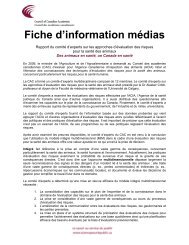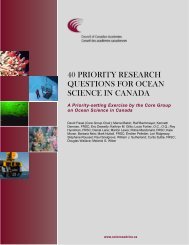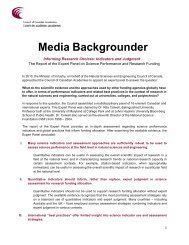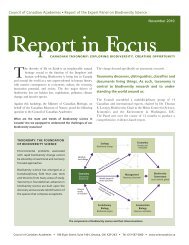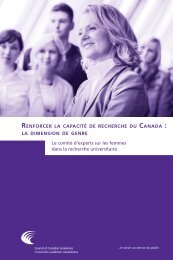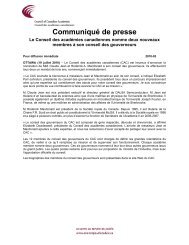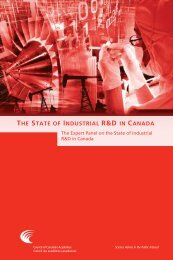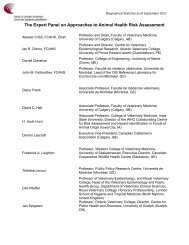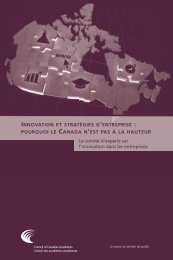an assessment of the evidence - Council of Canadian Academies
an assessment of the evidence - Council of Canadian Academies
an assessment of the evidence - Council of Canadian Academies
- No tags were found...
Create successful ePaper yourself
Turn your PDF publications into a flip-book with our unique Google optimized e-Paper software.
40 Influenza Tr<strong>an</strong>smission <strong>an</strong>d <strong>the</strong> Role <strong>of</strong> PPRE: An Assessment <strong>of</strong> <strong>the</strong> Evidencedecide on <strong>the</strong> distribution <strong>of</strong> respirators in <strong>the</strong> stockpile. For infrequent users, orthose who have not recently received training, re-training prior to use during ap<strong>an</strong>demic will be needed. Both adequate training <strong>of</strong> individuals in assessing <strong>the</strong> fit<strong>of</strong> <strong>the</strong> respirator each time it is used, as well as qualitative or qu<strong>an</strong>titative fit testing<strong>of</strong> individuals have been shown to improve facial fit. Most regulatory agencies <strong>an</strong>djurisdictions m<strong>an</strong>date that fit tests be conducted on <strong>an</strong> <strong>an</strong>nual basis.Respirators are designed specifically to ensure capture <strong>of</strong> particles in <strong>the</strong> size r<strong>an</strong>gethat c<strong>an</strong> be inhaled into <strong>the</strong> respiratory tract, including <strong>the</strong> entire r<strong>an</strong>ge referred toas “inhalable” which includes nasopharyngeal, tracheobronchial <strong>an</strong>d alveolar-sizedparticles. A non-fit-tested respirator allows gaps between <strong>the</strong> PPRE <strong>an</strong>d <strong>the</strong> user’sface that inhalable particles c<strong>an</strong> easily pass through, <strong>the</strong>reby bypassing <strong>the</strong> filter.Clearly, this would compromise <strong>the</strong> ability <strong>of</strong> <strong>the</strong> respirator to serve as a PPRE.A recent publication by Duling et al. (2007) examined <strong>the</strong> level <strong>of</strong> protectionafforded by fit tested <strong>an</strong>d non-fit-tested respirators. This study reported <strong>an</strong> assignedprotection factor (APF) <strong>of</strong> 4.6 when respirators that did not fit properly wereincluded in <strong>the</strong> dataset. The APF increased to about 10 when respirators that didnot pass qualitative fit tests were removed <strong>an</strong>d <strong>the</strong> APF increased even fur<strong>the</strong>r, to14.5, when respirators that did not pass <strong>the</strong> qu<strong>an</strong>titative test were removed.User AdherenceA respirator c<strong>an</strong>not protect a wearer who does not know when to use it or how towear it. Recent studies carried out in C<strong>an</strong>ada, <strong>the</strong> United States <strong>an</strong>d <strong>the</strong> UnitedKingdom have shown that user compli<strong>an</strong>ce within institutional protocols for PPREis less th<strong>an</strong> 100 per cent. Adherence is known to be associated with effective trainingprograms <strong>an</strong>d with workplace safety climate. 16 Workers who have beenengaged in <strong>the</strong> pl<strong>an</strong>ning steps <strong>of</strong> institutional protocols, <strong>an</strong>d feel properly trainedin <strong>the</strong> use <strong>of</strong> <strong>the</strong>ir protective equipment, are far more likely to comply withinstitutional safety policies (Yassi, 2004; DeJoy, 1996).Comfort <strong>an</strong>d Perform<strong>an</strong>ceThe response <strong>of</strong> individuals to <strong>the</strong> use <strong>of</strong> respirators involves both physiological<strong>an</strong>d psychological factors (Harber, 1988). The domin<strong>an</strong>t physiological effect is <strong>the</strong>increase in inspiratory resist<strong>an</strong>ce brought on by <strong>the</strong> airflow resist<strong>an</strong>ce provided by<strong>the</strong> respirator. Relative to o<strong>the</strong>r types <strong>of</strong> respirators, <strong>the</strong> N95 particulate facepiece16 The safety culture is <strong>the</strong> org<strong>an</strong>izational commitment to safety (policies, training, provision <strong>of</strong> PPE).The safety climate is <strong>the</strong> collective employee perception <strong>of</strong> that safety culture (Gershon, 2007; Yassi,2004). It is <strong>the</strong> safety climate that has been shown to be a far more reliable predictor <strong>of</strong> compli<strong>an</strong>ce.





